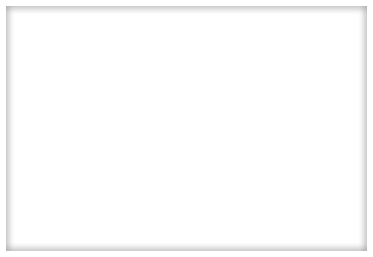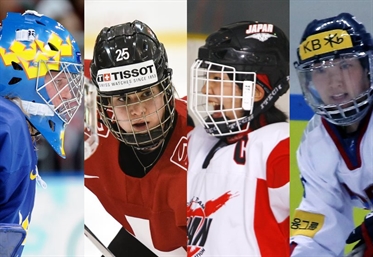Group B: Fighting for playoffs
Group B: Fighting for playoffs
Euros the favourites, but don’t forget the Asians

 Two European nations (pictured Swedish goalie Sara Grahn and Swiss forward Alina Muller) will be fighting with two Asian countries (pictured Japan’s Chiho Osawa and Korea’s Yoonjung Park) for berths in the quarter-finals in an historic tournament for women’s hockey. Photos: Matthew Manor, Matt Zambonin, Phillip MacCallum / HHOF-IIHF Images, Jae-Shin Roh
Two European nations (pictured Swedish goalie Sara Grahn and Swiss forward Alina Muller) will be fighting with two Asian countries (pictured Japan’s Chiho Osawa and Korea’s Yoonjung Park) for berths in the quarter-finals in an historic tournament for women’s hockey. Photos: Matthew Manor, Matt Zambonin, Phillip MacCallum / HHOF-IIHF Images, Jae-Shin Roh
Sweden
As Leif Boork heads off into the coaching sunset, he takes with him an experienced roster to Korea for his final tournament. Sweden’s golden era was between 2002 and 2007, when it won all its four medals in World Women’s and Olympic competition. Before and since, it has been a series of frustrating events.
On the bright side, the U18 team has had recent success and several of those players are rounding into excellent senior players now. Since Sochi, the team has placed 5th, 5th, and 6th at the WW, but now is the time for such young stars as Hanna Olsson, Olivia Carlsson, and Sara Hjalmarsson to make their mark and establish a new era.
Having said that, there are some nine players back from the Sochi Olympics, including goalie Sara Grahn, a backup then and a number-one goalie now. Pernilla Winberg is the forward to watch. The 28-year-old is in her 15th consecutive tournament dating back to 2004.
The Swedes had a tough time at the Four Nations tournament in Florida last November. Playing with Finland and the North Americans, the Swedes lost all four games by a collective score of 19-2. The only ray of hope was a narrow 2-1 overtime loss to Suomi on the final day.
Switzerland
Coach Daniela Diaz, back for a third year, has perhaps the toughest challenge of any bench boss in PyeongChang. The Swiss have finished 6th, 7th, and 7th in the last three Women’s Worlds after the 2014 Olympics in which the women had their most memorable event ever.
That year they made it to the bronze-medal game but trailed Sweden 2-0 after 40 minutes. They rallied in the third, though, winning 4-3 and earning an historic bronze. Can they do it again? It will be tougher this time ‘round because they are starting in the second tier of teams.
The Swiss have made only four changes to the roster from a year ago at the WW in Plymouth, Michigan. In goal, they have 28-year-old Florence Schelling, in her fourth Olympics. Indeed, no other Swiss goalie has played a minute of WW or OG action in nearly a decade, and it’s safe to say as she goes, so goes the Swiss chances of victory.
If she represents the back end, then up front it’s the dynamic duo of Alina Muller and Lara Stalder, who have great chemistry, speed, and youth on their side. But it’s offence from others that will be critical, and it’s great team defence in front of Schelling that will be equally important in determining the Swiss fate this Olympics.
Japan
In April 2016, Japan finished in last place at the Women’s Worlds in Kamloops, British Columbia, Canada and was demoted to Division I. It was a disappointing result, to be sure, but since then the Japanese have come back stronger than ever, winning two big tournaments and placing themselves in the thick of things for this year and next.
In Graz, Austria, last April, they beat the hosts, 4-1, en route to first place in that lower division to earn promotion to the top level of the WW for 2019. This came just two months after an even more dramatic win when they hosted the final qualification event for PyeongChang and won.
On the final day, the Japan-Germany result would determine which of the two nations would qualify for the Olympics. Japan raced out to a 2-0 lead in the second period and held on for a 3-1 win on home ice in Tomakomai.
Japan played in the 1998 Games as hosts, but didn’t qualify for the next three Olympics. Being close to home now, after finishing in last place in Sochi, is a positive sign for a team hoping to establish itself among the top eight on a regular basis. However, a staggering 15 players from Sochi are back, a sign of a thin talent pool from which to choose.
Korea
On the surface, it doesn’t look good. Korea has never played at the U18 Women’s Championship and has never qualified for the senior Women’s Worlds mostly playing in the fourth or fifth tier. Indeed, they are in the tournament as hosts, so it would seem they have little chance of playing to the level of the top seven nations in the world.
Add to the mix the fact that coach Sarah Murray has had politics – good news politics, to be sure – impose itself on her methods. Despite building a team over the last two years, she now has 12 players from North Korea to integrate on her roster. That is, “Korea”, a combination of players from the North and South, is now a mixed team of 35 players. Every game Murray will select a new line-up and will have at least three players from the North playing. Tricky can’t begin to describe the challenge that lies ahead for her despite having a larger tournament roster.
However, there is good news. In the leadup to these Olympics, Murray’s team has acquitted itself with great respect. In the last year Koreans have played games against all teams in their group in the upcoming Olympics. In February 2017, at the Asian Winter Games, they lost by a very respectable 3-0 score to Japan. And, just last August, they played the Swiss twice, losing 2-1 in overtime and 5-2. Even just last Sunday, the combined Korean team played Sweden in an exhibition game in Incheon and lost only 3-1. Korea isn’t going to be a medal contender, but so far the results indicate they won’t be blown away either.
Format
The teams and groups were seeded according to the 2016 IIHF Women’s World Ranking. The tournament includes the top-five nations, two qualifiers and host Korea. The top-four ranked teams are seeded in Group A, the other teams in Group B.
The two top teams from Group A will receive byes to the quarter-finals, thus moving automatically to the semi-finals. The quarter-finals will be played between 3A-2B and 4A-1B. The winners of these games advance to the semis with 1A taking on the winner of 4A-1B and 2A playing the winner of 3A-2B.
The winner of each semi-finals game will advance to the gold-medal game, while the losers will play for the bronze.
Predictions
As in Group A, there is a clear and distinct gap between the top two and bottom two teams in Group B. It would take something of a miracle for either Asian nation to qualify for the quarters, and it would be a stunning disappointment for either European team to fail to advance although in one game nothing is impossible.
The reasons are simple. The talent pool is much deeper in Europe, and that means the skill level is higher, the coaching can be more effective, and the implementation of game strategy more successful. In the end, Sweden and Switzerland should normally move on to the quarters at the expense of Japan and Korea.
Back to Overview







































